William Thomas State Forest
Geography of New HampshireMerrimack County, New HampshireNew Hampshire geography stubsNew Hampshire state forestsNortheastern United States protected area stubs ... and 1 more
Protected areas of Merrimack County, New Hampshire
William Thomas State Forest is a 1,660-acre (670 ha) state forest in the town of Hill, New Hampshire, in the United States. It is named for Harvard University class of 1945 graduate and B-24 Liberator pilot William H. Thomas Jr. who used his discharge pay to acquire 60 wooded acres and subsequently expanded his holdings to about 1,700. He had visions of a resort development, but retreated to the area in 1987 and donated the lands to the state of New Hanpshire when he died in 2001. The area reportedly has some double track but no single track trails.
Excerpt from the Wikipedia article William Thomas State Forest (License: CC BY-SA 3.0, Authors).William Thomas State Forest
State Route 3A,
Geographical coordinates (GPS) Address Nearby Places Show on map
Geographical coordinates (GPS)
| Latitude | Longitude |
|---|---|
| N 43.545555555556 ° | E -71.733055555556 ° |
Address
State Route 3A
State Route 3A
03243
New Hampshire, United States
Open on Google Maps










